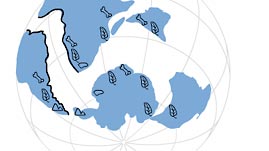Teachers' Domain - Digital Media for the Classroom and Professional Development
User: Preview

Source: Exploratorium
This interactive activity adapted from the Exploratorium presents evidence that supports the theory of plate tectonics, which explains how and when continents have shifted position over time. Geological and biological evidence have played important roles in forming the theory, and in return the theory has provided answers to some challenging questions.
When European explorers first began traveling the world, they brought back accounts of bizarre creatures that no one could have imagined. Equally baffling was the manner in which they found organisms distributed around the globe. Continents on opposite sides of the world shared many species in common, while two landmasses much closer in proximity were home to groups of plants and animals that differed greatly. Early scientists also found fossil evidence of plants and animals existing in places where they couldn't possibly survive given the climatic conditions of the day. Dinosaurs, for example, seemed like a poor fit for life on Antarctica, yet their remains were found there. Scores of similar observations raised new questions, but because Earth's continents were assumed to be static, these questions remained unanswered.
The theory of continental drift, and later the theory of plate tectonics, revolutionized not only geology, but biology as well, by postulating that the position of continents had shifted over time. Suddenly, many of the questions had plausible explanations. In fact, these early observations, along with the questions they generated, provided a rich foundation for developing the theory in its early stages. Alfred Wegener, the champion of the theory of continental drift, compared assemblages of fossilized plants and animals, as well as similar rock types found oceans apart. The patterns he saw, such as the existence of the same type of rock on opposite sides of the Atlantic Ocean, helped support his theory that all continents were once connected, that they formed a single supercontinent, Pangaea, and that the supercontinent has since split up.
Although Wegener was unable to explain the mechanism by which continents might split up and move across the globe, thus forming different configurations of continents over time, his detailed observations led the way to the modern theory of plate tectonics. Scientists now know that Earth's crust, which encompasses all of the continents and the seafloor, is made up of a patchwork of a dozen major and several minor tectonic plates. These plates move independently and shift uneasily atop Earth's molten mantle. Circular convection currents in the mantle are thought to be the driving force that pushes plates together or pulls them apart.
It is also widely accepted that all of Earth's continents were once connected and that, over time, they broke apart and drifted away from each other. In fact, fossil evidence has helped scientists place many important geological events on a timeline. The theory also continues to answer some interesting evolutionary questions. For example, did the giant flightless birds of the world—South America's rhea, Australia's emu, and Madagascar's now extinct elephant bird—arrive by wing power and then become flightless, or did they walk? Scientists now think that an early ancestor of these birds dispersed on foot prior to the breakup of the supercontinent Gondwanaland, a part of Pangaea that included most of the landmasses in today's southern hemisphere.
 Loading Standards
Loading Standards Teachers' Domain is proud to be a Pathways portal to the National Science Digital Library.
Teachers' Domain is proud to be a Pathways portal to the National Science Digital Library.
